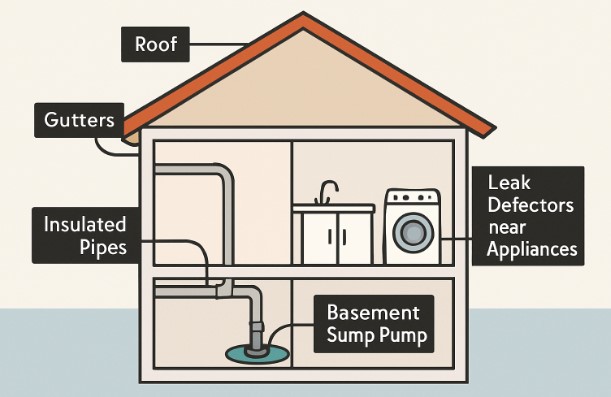Physical Address
304 North Cardinal St.
Dorchester Center, MA 02124
Physical Address
304 North Cardinal St.
Dorchester Center, MA 02124

Water damage is one of the most common and costly disasters homeowners face. When left unchecked, even a small leak can develop into extensive structural issues or health hazards, such as mold. Being proactive and implementing preventive measures can significantly reduce the risk of damage, saving you time, money, and stress. If you’ve recently experienced a leak or flooding, it’s crucial to prioritize residential water damage mitigation right away; prevention is always better than a cure.
Homeowners are often surprised by how quickly water can inflict lasting harm. Cracked foundations, warped floors, ruined furniture, and even electrical hazards are just a few of the ways water can negatively impact your home. The good news is that with regular maintenance and awareness, most water damage can be prevented. These practical steps will help you protect your investment and your family’s well-being.
Read on for essential actions every homeowner should take to lower their risk of water damage and safeguard their property for years to come.
Water leaks often start where you least expect them: behind washing machines, dishwashers, or underneath bathroom sinks. Regularly inspect all water-using appliances and exposed plumbing for any signs of leaks, corrosion, or loose fittings. Replacing hoses and connections every five years—especially older rubber hoses—with more durable, steel-braided alternatives can help protect your home from sudden bursts or slow leaks. Making inspections a bi-annual habit ensures you catch minor issues long before they escalate.
Advanced technology makes it easier than ever to prevent water damage. Installing water leak detection devices in areas most vulnerable to leaks—such as basements, bathrooms, under sinks, or behind appliances—offers immediate alerts if moisture is detected where it shouldn’t be. Some smart devices even shut off your water supply automatically, minimizing potential water loss and avoiding more significant damage. These are particularly effective in properties left unattended, or for homeowners who travel frequently.
Roofs and gutters are your home’s first line of defense against heavy rain. Inspect your roof at least twice a year, checking for missing shingles, cracks, or signs of age. Gutters should be cleared of leaves and debris each season to prevent overflow and channel rainwater safely away from your foundation. Make sure downspouts direct water at least 6–10 feet away from your home. The U.S. Department of Housing and Urban Development offers additional guidance on keeping homes safe from water infiltration.
Poor grading around your house can cause rainwater to pool near the foundation, leading to leaks, warped flooring, and weakened walls. Adjust the landscaping and grade the soil so that it slopes away from your home, encouraging water to drain naturally toward the street or a storm sewer. Ensure that drains and French drains are unobstructed and in working order, especially if your neighborhood is prone to heavy rainfall or flash floods.
Frozen pipes are a notorious winter risk. When water freezes, it expands and can rupture pipes, leading to severe indoor flooding. Insulate all exposed pipes, especially those in unheated areas such as basements, attics, or garages. During cold spells, keep your thermostat set above 50°F (10°C) and open cabinet doors to allow warm air to circulate pipes. Don’t forget to disconnect hoses before the first freeze and drain external faucets to avoid ice blockages.
If you have a basement or live in a flood-prone area, sump pumps are invaluable for pumping out water before it accumulates. Test your sump pump each season to ensure it’s working, and consider investing in a battery backup system in case you lose power during a storm. Backwater valves, meanwhile, prevent municipal sewage from backing up into your house during heavy rain—a safeguard recommended by Erie Insurance.
Basements, bathrooms, and laundry rooms are at the highest risk for water damage, so use water-resistant building materials wherever possible. Opt for tile, vinyl, or sealed concrete flooring in these spaces, and use mold-resistant drywall or cement board behind tiles. If renovating, consider closed-cell spray foam or rigid foam insulation, which naturally resists water absorption. This strategy not only limits damage in a flood, but can also inhibit mold growth.
Standard homeowners’ insurance generally does not cover flooding or water seepage from outside sources. To avoid unpleasant surprises, review your policy in detail and discuss specific water damage exclusions with your agent. Purchasing separate flood insurance may be worthwhile, especially for those in high-risk areas. The Federal Emergency Management Agency (FEMA) offers guidance on selecting and understanding flood insurance coverage.
Consistently monitoring your home and performing routine maintenance are crucial strategies for preventing costly and destructive water damage. Regular inspections of plumbing systems, appliances, and vulnerable areas, such as basements, attics, and roofs, help identify potential issues before they escalate. Clearing gutters, checking seals, and addressing minor leaks promptly can prevent structural deterioration, mold growth, and damage to personal belongings. Staying proactive not only safeguards your financial investment but also protects the health and well-being of your family. By maintaining vigilance and committing to preventive care, you ensure that your home remains a safe, dry, and comfortable environment year-round, free from unexpected water-related problems.